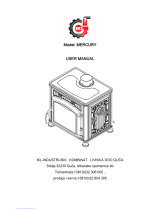RAIS PILAR 13L
RAIS PILAR 13L is an environmentally friendly wood burning stove that combines design and quality.
The stove has a nominal output of 4.8 kW and a heating area of 45-90 m2. It has a weight of approximately 144 kg and dimensions of 308-225-383 mm.
The PILAR 13L is easy to use and maintain. It features automatic regulation of combustion air, which ensures optimal combustion and efficiency. The stove also has a swivel base, which allows you to rotate it 360 degrees for optimal heat distribution.
RAIS PILAR 13L
RAIS PILAR 13L is an environmentally friendly wood burning stove that combines design and quality.
The stove has a nominal output of 4.8 kW and a heating area of 45-90 m2. It has a weight of approximately 144 kg and dimensions of 308-225-383 mm.
The PILAR 13L is easy to use and maintain. It features automatic regulation of combustion air, which ensures optimal combustion and efficiency. The stove also has a swivel base, which allows you to rotate it 360 degrees for optimal heat distribution.




















-
 1
1
-
 2
2
-
 3
3
-
 4
4
-
 5
5
-
 6
6
-
 7
7
-
 8
8
-
 9
9
-
 10
10
-
 11
11
-
 12
12
-
 13
13
-
 14
14
-
 15
15
-
 16
16
-
 17
17
-
 18
18
-
 19
19
-
 20
20
-
 21
21
-
 22
22
-
 23
23
-
 24
24
-
 25
25
-
 26
26
-
 27
27
-
 28
28
-
 29
29
-
 30
30
-
 31
31
-
 32
32
-
 33
33
-
 34
34
-
 35
35
-
 36
36
RAIS PILAR 13L
RAIS PILAR 13L is an environmentally friendly wood burning stove that combines design and quality.
The stove has a nominal output of 4.8 kW and a heating area of 45-90 m2. It has a weight of approximately 144 kg and dimensions of 308-225-383 mm.
The PILAR 13L is easy to use and maintain. It features automatic regulation of combustion air, which ensures optimal combustion and efficiency. The stove also has a swivel base, which allows you to rotate it 360 degrees for optimal heat distribution.
Ask a question and I''ll find the answer in the document
Finding information in a document is now easier with AI
in other languages
- dansk: RAIS PILAR 13L Brugermanual
Related papers
-
RAIS Pilar User manual
-
RAIS Pilar Instructions For Installation, Use And Maintenance Manual
-
RAIS PILAR 13 H User manual
-
RAIS Pilar User manual
-
RAIS PILAR 13 H User manual
-
RAIS Pilar Specification
-
RAIS X-Board User manual
-
RAIS Q-Tee 2 Instructions For Installation, Use And Maintenance Manual
-
RAIS attika Visio 2 Specification
-
RAIS POLEO 95 User manual
Other documents
-
Contura i50 Operating instructions
-
Contura I60 Operating instructions
-
Contura I60 Operating instructions
-
 IKL Mercury User manual
IKL Mercury User manual
-
Heta Scan-Line 500 Operating instructions
-
CDA dk750 User manual
-
Piazzetta 555T A Instructions For Installation, Use And Maintenance Manual
-
Heta Scan-Line Turin Operating instructions
-
Heta Scan-Line 800 side windows Operating instructions
-
Heta Scan-Line 550 insert Operating instructions




































